Although this website has a strong impetus toward a movie media style resource library, it is impossible to distance ourselves from the need to study and research the written word.
This can be a little overwhelming as there are so many books and articles in circulation that are designed to confuse our minds and to steer us from the truth. As a consequence of this, it is my intention to post links to books and downloads that I know can be of benefit. I believe that with these resources you will be able to confirm scripture, and to make sense of difficult doctrine. False doctrine will become a cinch to identify and you will be able to build the foundations of your faith upon solid ground, and not on quick sand as many have.
Some of these books I have included so that you might better see the inner workings of the system and the people behind the scenes doing the dirty work for the Devil. These will be easy to identify.
![]()
The Great Controversy Reference Material
![]()
Authors:
Holy Bible
The History of the Decline and Fall of Rome
Morals and Dogma
Babylonian Captivity of the Church
The Keys of this Blood-Malachi Martin
E. G. White
The Occult
The Catholic Encyclopedia
Luther’s 95 Theses
Lives of British Reformers
Secrets of the Federal Reserve Bank Eustace Mullins
SDA Pioneer writers
The Roman Catholic Catechism
Murder in Dealey Plaza
The Letters of Martin Luther
The Federal Reserve Conspiracy Eustace Mullins
The Jesuits and the Catholic Church
DAubigne
Foxe’s Book of Martyres
Source Book for Bible Students
From Sabbath to Sunday
![]()
top
Holy Bible
King James Bible 1611 Authorised Version 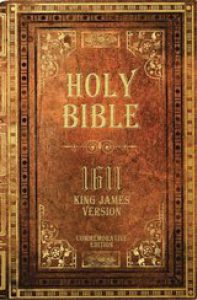
![]()
top
Ellen G White
top
SDA Pioneer Writings
J. N. Andrews
G. I. Butler
O. R. L. Crosier
Apollos Hale
J. N. Loughborough
T. M. Preble
Uriah Smith
E. A. Sutherland
Joseph Bates
M. E. Cornell
A. G. Daniells
Steven N. Haskell
P. T. Magan
W. W. Prescott
Samuel S. Snow
E. J. Waggoner
Sylvester Bliss
R. F. Cottrell
Charles Fitch
A. T. Jones
William Miller
Annie Smith
J. M. Stephenson
H. D. Ward
top
The Jesuits and the Roman Catholic Church-State System
Recommended Reading below plus the feature book Vatican Assassins.
A Complete History of the Popes of Rome
Fifty Years in the Church of Rome
Roman Catholicism
The Jesuit Conspiracy The Secret Plan of the Order
The Two Babylons A-Hislop
The Thrilling Mysteries of a Convent Revealed
Babylon Mother Church
Futurisms Faulty Foundations
Romanism and the Reformation
The Mysterie of Iniquitie
The Two Republics
Trilaterals-v1
Was Peter the First Pope
The Awful Disclosures of Maria Monk
Black Pope
History of Romanism
Romanism as a World Power
The Papacy
The Footprints of the Jesuits
Vatican Design Exposed
The History of Romanism
Crisis Enemies of America Unmasked
Engineer Corps of Hell
History of the Jesuits
Secret Instructions of the Jesuits
The Priest the Woman and the Confessional
The Jesuits
Vicars of Christ
Popery Puseyism and Jesuitism
Vatican Assassins 3rd Edition
Eric Jon Phelps Download
Vatican Assassins Title Page, Copyright, Assassins & Maxims Vatican Assassins: “Wounded In The House Of My Friends” The Diabolical History of The Society of Jesus Including: Its Second Thirty Years’ War (1914 – 1945), Its Cold War (1945 – 1989), And Its Assassination of America’s First Roman Catholic President, Knight of Columbus John Fitzgerald Kennedy (1963) By Eric Jon Phelps White Separatist American Freeman Dispensational, Fifth Monarchy, Seventh-Day Baptist-Calvinist 3 4 Vatican Assassins Vatican Assassins: “Wounded In The House Of My Friends” Eric Jon Phelps Copyright © 2001 Second Edition: CD/PDF March 2004 All rights reserved. Permission is hereby granted to anyone to quote From VATICAN ASSASSINS: “Wounded In The House Of My Friends”, in small portions only, for non-commercial use provided there is no content change, and full credit is given to the author and to the publisher,
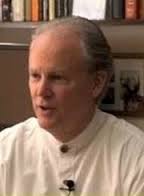 Eric Jon Phelps (born 1953) is an author and protagonist in the Truth Seeker movement in the United States, he is a Calvinist Protestant, and author of this book Vatican Assassins.
Eric Jon Phelps (born 1953) is an author and protagonist in the Truth Seeker movement in the United States, he is a Calvinist Protestant, and author of this book Vatican Assassins.
You can search the internet high and low for positive information on Eric Phelps but you will find precious little, for anybody who stands against the powers that be, and who’s stated purpose it is to expose their activities and their designs will of course be subjected to disparaging attacks on his character, many of which are fabrications.
If you have heard Eric in any broadcast interviews or watched him on any of the many video documentaries which he has been a part of then you will most likely have formed an opinion of his character, and it will most likely be of either hate,.or of admiration. It is not my intention to pass judgement nor opinion on the character of any man, as there is One Who Knows All, and it is He who will pass judgement on all men. Although it must be said that I do not agree with many of the personal beliefs of Eric Jon Phelps, I dare not deny the truths that he presents to us with respect to the subjects disclosed in his book. I first read Vatican Assassins 7-8 years ago and have, in the time since then been successful in proving the accuracy and the integrity of the information contained in it. This book is a masterpiece of research, and presentation and I find no trace of embellishment or vilification of any individual, the facts speak for themselves and there is no need for exaggeration.
I personally find Eric to be of sound moral conviction, he says he is a Christian and of the truth of that statement I have no doubt, and after having read this marvellous book I can do nothing but recommend this publication to all people who are genuinely interested in learning the HARD TRUTH, as I believe it to be of the utmost importance for understanding the nature, and of the designs of the Jesuit order.
I do feel that I must impress upon the mind of the reader the importance of searching the information that our Saviour Jesus Christ has given to us through His servants, and as such I thoroughly recommend this book as a must read.
1. The Superior General of the Jesuits The Black Pope, Adolfo Nicolas and his 6 generals control the “White Pope” Pope Francis I and the Holy See.
2. The Illuminati, Zionists, globalist Elites, Council on Foreign Relations, Bilderberg group, Freemasons, Council of 300 and the evil Council of Trent.
3. The Jesuits control the Knights Templar, Knights of Columbus and the Knights of Malta.
4. The CIA, FBI, NSA, ASIO, MI5, MI6, NCIS, FSB, DGSE, Mossad and every intelligence agency in the world are masonic and controlled by the Jesuits.
5. The Jesuits have infiltrated all governments & Leaders like Obama, Rudd, Blair, Jintao, Sarkozy, Peres are only puppets that carry out Jesuit orders.
Superiors General are elected by the General Congregation of the Society, summoned upon the resignation, retirement or death of an incumbent. Superiors General are elected for life and almost all have served life terms, the exceptions being Father Pedro Arrupe (resigned for reasons of failing health) and his successor, Father Peter Hans Kolvenbach. Kolvenbach’s resignation was announced in February 2006, which led to the convocation of the 35th General Congregation. That General Congregation elected the current Superior General of the Society, Father Adolfo Nicolás, who succeeded Kolvenbach.
In turn, Adolfo Nicolás being the thirtieth and current Superior General declared his intention in 2014 to resign the position at the 36th general congregation in 2016. It is at this meeting that the Jesuit Generals will elect a replacement.
top
DAubigne
![]() History of the Reformation in the Sixteenth Century
History of the Reformation in the Sixteenth Century
by Jean-Henri Merle d’Aubigné
Jean-Henri Merle d’Aubigné (16 August 1794 – 21 October 1872) was a Swiss Protestant minister and historian of the Reformation.
D’Aubigne was born at Eaux Vives, a neighbourhood of Geneva. A street in the area is named after him. The ancestors of his father Robert Merle d’Aubigné (1755–1799), were French Protestant refugees. The life Jean-Henri’s parents chose for him was in commerce; but in college at the Académie de Genève, he instead decided on Christian ministry. He was profoundly influenced by Robert Haldane, the Scottish missionary and preacher who visited Geneva and became a leading light in Le Réveil, a conservative Protestant evangelical movement.
When d’Aubigne went abroad to further his education in 1817, Germany was about to celebrate the tercentenary of the Reformation; and thus early he conceived the ambition to write the history of that great epoch. Studying at Berlin University for eight months 1817–1818, d’Aubigne received inspiration from teachers as diverse as J. A. W. Neander and W. M. L. de Wette.
In 1818, d’Aubigné took the post of pastor of the French Protestant church at Hamburg, where he served for five years. In 1823, he was called to become pastor of the Franco-German Brussels Protestant Church and preacher to the court of King William I of the Netherlands of the House of Orange-Nassau.
During the Belgian revolution of 1830, d’Aubigne thought it advisable to undertake pastoral work at home in Switzerland rather than accept an educational post in the family of the Dutch king. The Evangelical Society had been founded with the idea of promoting evangelical Christianity in Geneva and elsewhere, but a need arose for a theological seminary to train pastors. On his return to Switzerland, d’Aubigné was invited to become professor of church history in such a seminary, and he also continued to labor in the cause of evangelical Protestantism. In him the Evangelical Alliance found a hearty promoter. He frequently visited England, was made a D.C.L. v Oxford University, and received civic honors from the city of Edinburgh. He died suddenly in 1872.
The first portion of d’Aubigne’s Histoire de la Reformation – History of the Reformation of the Sixteenth Century – which was devoted to the earlier period of the movement in Germany, i.e., Martin Luther’s time, at once earned a foremost place among modern French ecclestical historians, and was translated into most European languages. The second portion, The History of the Reformation in Europe in the Time of Calvin, dealing with reform in the French reformer’s sphere, exhaustively treats the subject with the same scholarship as the earlier work, but the second volume did not meet with the same success.
Among minor treatises authored by d’Aubigne, the most important are his vindication of the character and the aims of Oliver Cromwell, and his sketch of the trendings of the Church of Scotland.
top
The History of the Decline and Fall of Rome
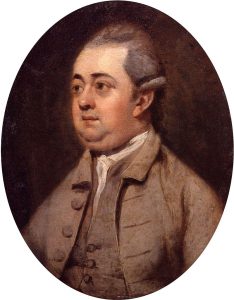
The History of the Decline and Fall of the Roman Empire
Volume 1 Volume 2 Volume 3
Volume 4 Volume 5 Volume 6
Volume 7 Volume 8 Volume 9
Volume 10 Volume 11 Volume 12
The History of the Decline and Fall of the Roman Empire[1] is a book of history written by the English historian Edward Gibbon, which traces the trajectory of Western civilization (as well as the Islamic and Mongolian conquests) from the height of the Roman Empire to the fall of Byzantium. It was published in six volumes. Volume I was published in 1776 and went through six printings.[2] Volumes II and III were published in 1781;[3][4] volumes IV, V, and VI in 1788–89.[5][6][7] The original volumes were published in quarto sections, a common publishing practice of the time. The work covers the history, from 98 to 1590, of the Roman Empire, the history of early Christianity and then of the Roman State Church, and the history of Europe, and discusses the decline of the Roman Empire in the East and West. Because of its relative objectivity and heavy use of primary sources, unusual at the time, its methodology became a model for later historians. This led to Gibbon being called the first “modern historian of ancient Rome”.
Gibbon offers an explanation for the fall of the Roman Empire, a task made difficult by a lack of comprehensive written sources, though he was not the only historian to attempt the task.
According to Gibbon, the Roman Empire succumbed to barbarian invasions in large part due to the gradual loss of civic virtue among its citizens. They had become weak, outsourcing their duty to defend their empire to barbarian mercenaries, who then became so numerous and ingrained that they were able to take over the Empire. Romans, he believed, were unwilling to live a tougher, military lifestyle. In addition, Gibbon argued that Christianity created a belief that a better life existed after death, which fostered an indifference to the present among Roman citizens, thus sapping their desire to sacrifice for a larger purpose. He also believed that Christianity’s comparative pacifism tended to hamper the traditional Roman martial spirit. Finally, like other Enlightenment thinkers and British citizens of the age steeped in institutional anti-Catholicism, Gibbon held in contempt the Middle Ages as a priest-ridden, superstitious Dark Age.
It was not until his own era, the “Age of Reason,” with its emphasis on rational thought, it was believed, that human history could resume its progress.
Gibbon saw the Praetorian Guard as the primary catalyst of the empire’s initial decay and eventual collapse, a seed planted by Augustus when the empire was established. His writings cite repeated examples of the Praetorian Guard abusing their power with calamitous results, including numerous instances of imperial assassination and incessant demands for increased pay.
He compared the reigns of Diocletian (284–305) and Charles V (1519–1556), noting superficial similarities. Both were plagued by continual war and compelled to excessive taxation to fund wars, both chose to abdicate as Emperors at roughly the same age, and both chose to lead a quiet life upon their retirement. However, Gibbon argues that these similarities are only superficial and that the underlying context and character of the two rulers is markedly different. (Source Wikipedia)
top
Morals and Dogma
Another resource for reference purposes only, and to help you to see and understand how it is that this system uses secret societies, and specifically the Freemasons in this instance to gain control of, and to mould the minds of the people. The words in this book come from the hand, and with the authority of arguably the most celebrated Freemason in North America; Albert Pike.
Pike first joined the Independent Order of Odd Fellows in 1840, and he had then joined a Masonic Lodge, where he became extremely active in the affairs of the organization, being elected Sovereign Grand Commander of the Scottish Rite’s Southern Jurisdiction in 1859.[9] He remained Sovereign Grand Commander for the remainder of his life (a total of thirty-two years), devoting a large amount of his time to developing the rituals of the order. Notably, he published a book called Morals and Dogma of the Ancient and Accepted Scottish Rite of Freemasonry in 1871, of which there were several subsequent editions. Pike stated that half of the text was copied from other works, but did not indicate his sources.
Pike is still regarded in America as an eminent and influential Freemason, primarily in the Scottish Rite Southern Jurisdiction.
Pike died in Washington, D.C., at the age of 81, and was buried at Oak Hill Cemetery. Burial was against his wishes; he had left instructions for his body to be cremated. In 1944, his remains were moved to the House of the Temple, headquarters of the Southern Jurisdiction of the Scottish Rite. A memorial to Pike is located in the Judiciary Square neighborhood of Washington, D.C.
The Albert Pike Memorial Temple is a historic Masonic lodge in Little Rock, Arkansas listed on the National Register of Historic Places.
![]()
top
The Occult: Tread carefully with these works.
I post these works for those who are strong in Christ and have established their house upon solid foundations.
These books may be helpful for those that wish to understand the sinister and evil machinations of the devil, and the influence that he holds over those that indulge in the occult. They may also be invaluable for discovering the methodology of the Satanists so that we may see their works clearly, and better prepare ourselves as we watch prophecy fulfill.
![]()
top
The Roman Catholic Catechism
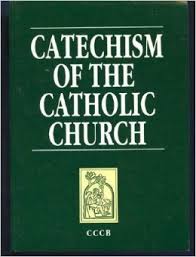 I have included this volume in the reading list for research and reference purposes ONLY. This book and the Roman Catholic System have no place in the lives of the followers of Christ. Please research the Catholic Doctrines page which can be found here and a larger portion of this site will show the errors of accepting or following the teachings in this book and the teachings of Rome. Note: I emphasise that I give you this for reference purposes ONLY so that you might confirm various claims which you might find on other pages of this website.
I have included this volume in the reading list for research and reference purposes ONLY. This book and the Roman Catholic System have no place in the lives of the followers of Christ. Please research the Catholic Doctrines page which can be found here and a larger portion of this site will show the errors of accepting or following the teachings in this book and the teachings of Rome. Note: I emphasise that I give you this for reference purposes ONLY so that you might confirm various claims which you might find on other pages of this website.
Download the book
![]()
top
The Catholic Encyclopedia
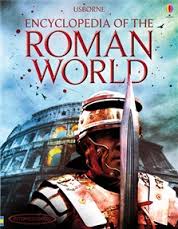 This pdf document contains all the online links to the complete 18 volume set of the Catholic Encyclopedia.
This pdf document contains all the online links to the complete 18 volume set of the Catholic Encyclopedia.
Once again I have included this pdf list on this page purely for research and reference purposes ONLY. This book, and the Roman Catholic System have no place in the lives of the followers of Christ. Please research the Catholic Doctrines page which can be found here and a larger portion of this site will show the errors of accepting or following the teachings in this book and the teachings of Rome. Note: I emphasise that I give you this for reference purposes ONLY so that you might confirm various claims which you might find on other pages of this website.
Catholic Encyclopedia Download
![]()
top
Foxe’s Book of Martyres
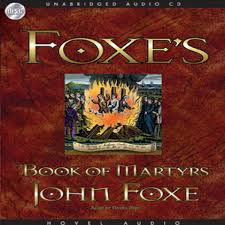 John Foxe (1516/17[1] – 18 April 1587) was an English historian and martyrologist, the author of Actes and Monuments (popularly known as Foxe’s Book of Martyrs), an account of Christian martyrs throughout Western history but emphasizing the sufferings of English Protestants and proto-Protestants from the fourteenth century through the reign of Mary I. Widely owned and read by English Puritans, the book helped mould British popular opinion about the Catholic Church for several centuries.
John Foxe (1516/17[1] – 18 April 1587) was an English historian and martyrologist, the author of Actes and Monuments (popularly known as Foxe’s Book of Martyrs), an account of Christian martyrs throughout Western history but emphasizing the sufferings of English Protestants and proto-Protestants from the fourteenth century through the reign of Mary I. Widely owned and read by English Puritans, the book helped mould British popular opinion about the Catholic Church for several centuries.
Foxe was born in Boston, in Lincolnshire, England, of a middlingly prominent family and seems to have been an unusually studious and devout child. In about 1534, when he was about sixteen, he entered Brasenose College, Oxford, where he was the pupil of John Hawarden (or Harding), a fellow of the college. In 1535 Foxe was admitted to Magdalen College School, where he may either have been improving his Latin or acting as a junior instructor. He became a probationer fellow in July 1538 and a full fellow the following July.
Foxe took his bachelor’s degree on 17 July 1537, his master’s degree in July 1543, and was lecturer of logic, 1539–40. A series of letters in Foxe’s handwriting dated to 1544–45, shows Foxe to be “a man of friendly disposition and warm sympathies, deeply religious, an ardent student, zealous in making acquaintance with scholars.” By the time he was twenty-five, he had read the Latin and Greek fathers, the schoolmen, the canon law, and had “acquired no mean skill in the Hebrew language.”
Foxe resigned from his college in 1545 after becoming a Protestant and thereby subscribing to beliefs condemned by the Church of England under Henry VIII. After a year of “obligatory regency” (public lecturing), Foxe would have been obliged to take holy orders by Michaelmas 1545, and the primary reason for his resignation was probably his opposition to clerical celibacy, which he described in letters to friends as self-castration. Foxe may have been forced from the college in a general purge of its Protestant members although college records state that he resigned of his own accord and “ex honesta causa”. Foxe’s change of religious opinion may have temporarily broken his relationship with his stepfather and may even have put his life in danger. Foxe personally witnessed the burning of William Cowbridge in September 1538.
After being forced to abandon what might have been a promising academic career, Foxe experienced a period of dire need. Hugh Latimer invited Foxe to live with him, but Foxe eventually became a tutor in the household of Thomas Lucy of Charlecote, near Stratford-on-Avon. Before leaving the Lucys, Foxe married Agnes Randall on 3 February 1547. They had six children.
![]()
top
Murder in Dealey Plaza
From the Back Cover
A rich and fresh collection of fascinating and darkly compelling revelations, demonstrating beyond any doubt the existence of conspiracy and cover-up behind the JFK assassination.
–Michael Parenti, author of History as Mystery
No jury would have convicted Lee Harvey Oswald in the face of the arguments set forth in this excellent volume. Murder in Dealey Plaza masterfully exposes the fallacies of the Warren Commission Report through objective, incontrovertible, medical, scientific, and investigative analyses of both old and new evidence. The conclusions are as solid as the credentials and research experience of the contributing authors. It is time that the truth in the JFK assassination be revealed and that Unites States history be rewritten.
–Cyril Wecht, M.D., J.D.; Past President, American Academy of Forensic Sciences
Murder in Dealey Plaza is a deeply disturbing book which documents the deceit and deception that marked the government’s handling of the evidence in the Kennedy assassination. The authors, all highly skilled professionals, describe the cover-up, from the falsification of the autopsy results to the alteration of the Zapruder film. Anyone who reads this work will be appalled by the systematic distortion of the truth-that JFK died as the result of a conspiracy-by certain officials of the U.S. government.
–Michael L. Kurtz, author of Crime of the Century
Fetzer and his team of experts uncover so many smoking guns that it’s impossible not to spot the fire that the Warren Commission and Gerald Posner have tried hard to deny. A thought-provoking and disturbingly compelling sequel to Assassination Science.
–Kerry Walters, Gettysburg College
Fetzer has assembled tense, suspenseful essays on our government’s perfidious efforts to conceal a conspiracy behind the assassination of President Kennedy. Two brains examined, photographs missing, X-rays altered, notes and reports burned, drawings fabricated. The account of JFK’s autopsy is more shocking than the story of Jekyll and Hyde.
–Stewart Galanor, author of Cover-Up
![]()
top
Babylonian Captivity of the Church
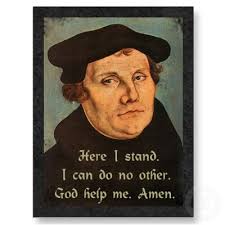 Prelude on the Babylonian Captivity of the Church (October 1520) was the second of the three major treatises published by Martin Luther in 1520, coming after the Address to the Christian Nobility of the German Nation (August 1520) and before On the Freedom of a Christian (November 1520). It was a theological treatise, and as such was published in Latin as well as German, the language in which the treatises were written.
Prelude on the Babylonian Captivity of the Church (October 1520) was the second of the three major treatises published by Martin Luther in 1520, coming after the Address to the Christian Nobility of the German Nation (August 1520) and before On the Freedom of a Christian (November 1520). It was a theological treatise, and as such was published in Latin as well as German, the language in which the treatises were written.
![]()
top
Luther’s 95 Theses
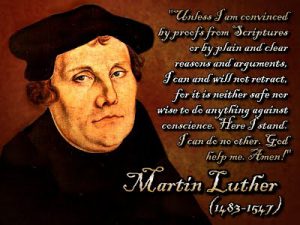 The 95 Theses which were to become the foundation of the Protestant Reformation were written in a remarkably humble and academic tone, questioning rather than accusing. The first two of the theses contained Luther’s central idea, that God intended believers to seek repentance and that faith alone, and not deeds, would lead to salvation. The other 93 theses, a number of them directly criticising the practice of indulgences, supported these first two.
The 95 Theses which were to become the foundation of the Protestant Reformation were written in a remarkably humble and academic tone, questioning rather than accusing. The first two of the theses contained Luther’s central idea, that God intended believers to seek repentance and that faith alone, and not deeds, would lead to salvation. The other 93 theses, a number of them directly criticising the practice of indulgences, supported these first two.
![]()
top
The Letters of Martin Luther
Martin Luther 10 November 1483 – 18 February 1546) was a German professor of theology, composer, priest, monk and a seminal figure in the Protestant Reformation. Luther rejected many of the teachings and practices of the Catholic Church. He strongly disputed the claim that freedom from God’s punishment for sin could be purchased with money, that is by indulgences, proposing an academic discussion of the practice and efficacy of indulgences in his Ninety-five Theses of 1517. His refusal to renounce all of his writings at the demand of Pope Leo X in 1520 and the Holy Roman Emperor Charles V at the Diet of Worms in 1521 resulted in his excommunication by the Pope and condemnation as an outlaw by the Emperor.
Luther taught that salvation and, subsequently, eternal life are not earned by good deeds but are received only as the free gift of God’s grace through the believer’s faith in Jesus Christ as redeemer from sin. His theology challenged the authority and office of the Pope by teaching that the Bible is the only source of divinely revealed knowledge from God, and opposed sacerdotalism by considering all baptised Christians to be a holy priesthood. Those who identify with these, and Luther’s wider teachings became known as Lutherans, though Luther insisted on Christian or Evangelical as the only acceptable names for individuals who professed Christ.
![]()
top
A History of The Holy Catholic Inquisition
Excerpt from the book.
The Pope of Rome has recently honoured the United Sates of America, and shown the deep interest he feels in this country, by the appointment of an ecclesiastical ambassador, a legate with plenary powers to manage the cause of Romanism in the new world. This high officer of the church and state of Rome, has expressed his gratitude and loyalty by appearing before the public, (at Baltimore) as the apologist and defender of the Inquisition.
The order of the Jesuits is restored, and, so far a we know, without any change in its constitution and character. The Romish missionaries to this country are mostly of the order of the Jesuits; for it is said by American citizens who have wintered at Rome, that the Jesuits who come here for commission and patronage, are specially ambitious of appointments to this country. They regard our country as an open field, where they may pursue their schemes without molestation, and with entire success; where they may profit by the toleration enjoyed under our mild and free institutions.
![]()
top
Source Book for Bible Students
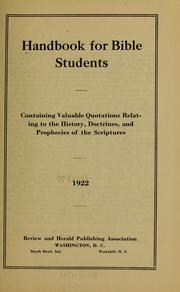 Source book for Bible students; containing valuable quotations relating to the history, doctrines, and prophecies of the Scriptures, 1922
Source book for Bible students; containing valuable quotations relating to the history, doctrines, and prophecies of the Scriptures, 1922
by Review and Herald Publishing Association
Source book for Bible students: Download
![]()
top
Lives of British Reformers
The lives of the British reformers from Wickliff to Foxe.
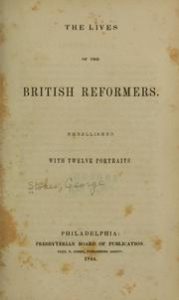 Within the last few years the characters of the British reformers have been assailed with unprecedented violence. They have been denounced as hypocrites and time-servers, and been charged with base subserviency to the will of a licentious despot, to gratify whose evil passions they sacrificed the welfare of England, the unity of the church, and the cause of truth. That such accusations should have been brought against them by avowed Romanists is not surprising. But it is a strange and startling circumstance that in our days the charges should have been echoed and exaggerated by members and ministers of the church of which they were chief founders, and for which they laid down their lives.
Within the last few years the characters of the British reformers have been assailed with unprecedented violence. They have been denounced as hypocrites and time-servers, and been charged with base subserviency to the will of a licentious despot, to gratify whose evil passions they sacrificed the welfare of England, the unity of the church, and the cause of truth. That such accusations should have been brought against them by avowed Romanists is not surprising. But it is a strange and startling circumstance that in our days the charges should have been echoed and exaggerated by members and ministers of the church of which they were chief founders, and for which they laid down their lives.
![]()
top
The Federal Reserve Conspiracy Eustace Mullins
In the fall of 1949 I went to the Library of Congress to get material for a newspaper article about the Federal Reserve Board of Governors. What I expected to be a week’s labour turned into a lengthy research job of nineteen months, for I discovered, in my initial enquiry, that there existed not one narrative account of the origins and activities of this powerful organisation. Consequently, the majority of my information was gathered piecemeal from a vast number of periodicals, ranging from popular magazines such as the Saturday Evening Post to the exclusive bankers magazine, The Economist’
The standard works on the Federal Reserve System, almost entirely abstruse and technical works on economics , I found of little practical value. Even in the matter of acceptances, the usual textbooks contained no information upon such an important item in America’s economic history as the changeover from the open book system of credit to the acceptance system, which has wrought such vast changes in our practice of commerce, and for this information I found only one source, a few pamphlets published by the American Acceptance Council from 1915 to 1928. It is, then, little wonder that the student with a Masters Degree in Economics from one of the better universities will see here for the first time material which should have been before him in his elementary courses.
The birthplace of the Federal Reserve Act, Jekyl Island, is now operated as a public park by the State of Georgia, but the tourist will find no plaque there commemorating the event. This is now so much an oversight on the part of the parks officials as it is a triumph for the more than adequate publicists of the Federal Reserve Board, who have perpetuated the comfortable fiction that the act was born in the halls of congress, the product of the minds of Carter Glass and Woodrow Wilson. It i the writers hope that this and many similar fictions will not long survive the publication of this work.
E. Mullins.
![]()
top
Secrets of the Federal Reserve Bank Eustace Mullins
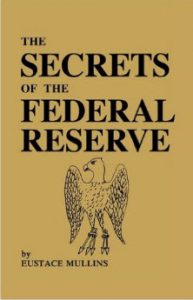 Mullins presents some bare facts about the Federal Reserve System with subjects on: it IS NOT a U.S. government bank; it IS NOT controlled by Congress; it IS a privately owned Central Bank controlled by the elite financiers in their own interest. The Federal Reserve elite controls excessive interest rates, inflation, the printing of paper money, and have taken control of the depression of prosperity in the United States.
Mullins presents some bare facts about the Federal Reserve System with subjects on: it IS NOT a U.S. government bank; it IS NOT controlled by Congress; it IS a privately owned Central Bank controlled by the elite financiers in their own interest. The Federal Reserve elite controls excessive interest rates, inflation, the printing of paper money, and have taken control of the depression of prosperity in the United States.
![]()
top
From Sabbath to Sunday – Carlyle B. Haynes
Somewhere in the dim ages between the time of Christ and our time, the observance of the Sabbath has been changed from the seventh day of the week to the first day. Certain it is that the command of God is for the sanctification and observance of the seventh day as the Sabbath.
There can be no mistaking the meaning here.
This is the command:
“Remember the sabbath day, to keep it holy. Six
days shalt thou labour, and do all thy work: but the
seventh day is the sabbath of the Lord thy God: in it
thou shalt not do any work, thou, nor thy son, nor thy
daughter, thy manservant, nor thy maidservant, nor thy
cattle, nor thy stranger that is within thy gates: for in six
days the Lord made heaven and earth, the sea, and all
that in them is, and rested the seventh day: wherefore
the Lord blessed the sabbath day, and hallowed it”
(Exodus 20:8-11).
![]()
top
The Keys of this Blood-Malachi Martin
Only Malachi Martin, consummate Vatican insider and intelligence expert, could reveal the untold story behind the Vatican’s role in today’s winner-take-all race against time to establish, maintain, and control the first one-world government.
* Will America lead the way to the new world order?
* Is Pope John Paul II winning the battle for faith?
* Is the breakup of the Soviet empire masking Gorbachev’s worldwide agenda?
The Keys of This Blood is a book of stunning geopolitical revelations. It presents a compelling array of daring blueprints for global power, and one of them is the portrait of the future.
![]()
top
The Reformers Before the Reformation: Emille De Bonnechose
Emile De Bonnechose (1801-1875) was a literary and historian of Holland
Before entering the details of the reign of Charles X of France , it is indispensable to give the reader an idea of the antecedents, and of the political line that followed with perseverance from 1789, since according to the modern historian Emilio de Bonnechose addict to the new ideas , one of the few men whose political conduct has offered no variation has been manifested (quoted from A. Saint-Prosper’s “History of France”, Barcelona, Brusi, 1841)
Bonnechose was born in Leyerdop, the Netherlands , on 18 August 1801 and died on 15 February 1875, and was brother of the Archbishop of Ruan Henri Bonnechose (1800-1883) who published the work of Louis Bautain (1796-1867) << Philosophie du christianisme: …, Paris, 1835, 2 vols. Ref: wikipedia Emille de Bonnechose
![]()
top
The Encyclopaedia Americana: Francis Lieber
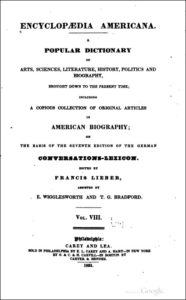 The original Encyclopædia Americana was published in the United States beginning in the late 1820s and continued with new editions and supplements into the 1850s. Other than the name, it had no connection with the Encyclopedia Americanathat began publishing in 1902 or the Americanized version of the Encyclopædia Britannica published in the 1880s.
The original Encyclopædia Americana was published in the United States beginning in the late 1820s and continued with new editions and supplements into the 1850s. Other than the name, it had no connection with the Encyclopedia Americanathat began publishing in 1902 or the Americanized version of the Encyclopædia Britannica published in the 1880s.
The Encyclopædia Americana. A popular dictionary of arts, sciences, literature, history, politics and biography, brought down to the present time; including a copious collection of original articles in American biography; on the basis of the 7th ed. of the German Conversations-Lexicon was founded by German-born Francis Lieber. It was the first full-size encyclopedia of American authorship, being preceded by Dobson’s Encyclopædia (1789–1798), and other American reprints of British encyclopedias, as well as a few compact American encyclopedias such as the four-volume Minor Encyclopedia of 1803, and the seven-volume Low’s Encyclopedia, of 1805-1811. Ref: Wikipedia Encyclopaedia Americana
![]()
top
The Life and Times of John Huss Vol 1 & Vol 2
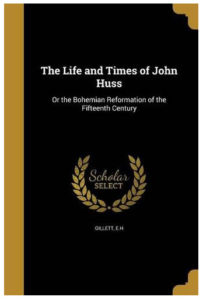 Jan Hus (/hʊs/; Czech: c. 1369 – 6 July 1415, sometimes Anglicized as John Hus or John Huss, was a Czech priest, philosopher, Master, dean and rector[3] at Charles University in Prague, church reformer, founder of Hussitism, a seminal figure in the Bohemian Reformation and a key predecessor to Protestantism.
Jan Hus (/hʊs/; Czech: c. 1369 – 6 July 1415, sometimes Anglicized as John Hus or John Huss, was a Czech priest, philosopher, Master, dean and rector[3] at Charles University in Prague, church reformer, founder of Hussitism, a seminal figure in the Bohemian Reformation and a key predecessor to Protestantism.
After John Wycliffe, the theorist of ecclesiastical Reformation, Hus is considered the first Church reformer, as he lived before Luther, Calvin, and Zwingli. His teachings had a strong influence on the states of Western Europe, most immediately in the approval of a reformist Bohemian religious denomination, and, more than a century later, on Martin Luther himself. He was burned at the stake for heresy against the doctrines of the Roman Catholic Church, including those on ecclesiology, the Eucharist, and other theological topics.
After Hus was executed in 1415, the followers of his religious teachings (known as Hussites) rebelled against their Roman Catholic rulers and defeated five consecutive papal crusades between 1420 and 1431, in what became known as the Hussite Wars. A century later, as many as 90% of inhabitants of the Czech lands were Hussites. Although Bohemia was the site of one of the most significant pre-reformation movements, there are only few Protestant adherents remaining in modern times; mainly due to historical reasons such as persecution of Protestants by the Catholic Habsburgs, particularly after the Battle of White Mountain in 1620; restrictions during the Communist rule; and also the ongoing secularization. Reference Source: Wikipedia Jan Hus
![]()
top
Roman Catholic and Protestant Confessions about Sunday
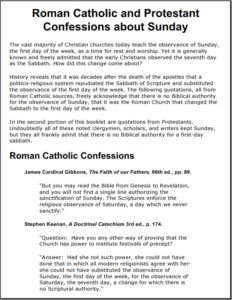 The vast majority of Christian churches today teach the observance of Sunday, the first day of the week, as a time for rest and worship. Yet it is generally
The vast majority of Christian churches today teach the observance of Sunday, the first day of the week, as a time for rest and worship. Yet it is generally
known and freely admitted that the early Christians observed the seventh day as the Sabbath. How did this change come about?
History reveals that it was decades after the death of the apostles that a politico-religious system repudiated the Sabbath of Scripture and substituted
the observance of the first day of the week. The following quotations, all from Roman Catholic sources, freely acknowledge that there is no Biblical authority
for the observance of Sunday, that it was the Roman Church that changed the Sabbath to the first day of the week.
In the second portion of this booklet are quotations from Protestants.
Undoubtedly all of these noted clergymen, scholars, and writers kept Sunday, but they all frankly admit that there is no Biblical authority for a first-day
sabbath.
![]()
top
The Acts and Monuments of John Foxe
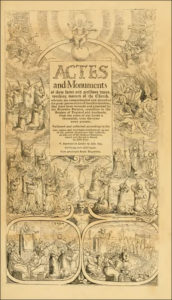 The Acts and Monuments, popularly known as Foxe’s Book of Martyrs, is a work of Protestant history and martyrology by John Foxe, first published in English in 1563 by John Day. It includes a polemical account of the sufferings of Protestants under the Catholic Church, with particular emphasis on England and Scotland. The book was highly influential in those countries and helped shape lasting popular notions of Catholicism there. The book went through four editions in Foxe’s lifetime and a number of later editions and abridgements, including some that specifically reduced the text to a Book of Martyrs. Reference resource Wikipedia Foxe’s Book of Martyres
The Acts and Monuments, popularly known as Foxe’s Book of Martyrs, is a work of Protestant history and martyrology by John Foxe, first published in English in 1563 by John Day. It includes a polemical account of the sufferings of Protestants under the Catholic Church, with particular emphasis on England and Scotland. The book was highly influential in those countries and helped shape lasting popular notions of Catholicism there. The book went through four editions in Foxe’s lifetime and a number of later editions and abridgements, including some that specifically reduced the text to a Book of Martyrs. Reference resource Wikipedia Foxe’s Book of Martyres
Volume 1 Download Link Volume 2 Download Link
Volume 3 Download Link Volume 4 Download Link
Volume 5 Download Link Volume 6 Download Link
Volume 7 Download Link Volume 8 Download Link
![]()
top
General History of the Christian Religion and Church: Dr. Augustus Neander
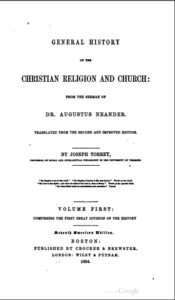 The nature of Gnosticism, as a reaction of the old principle in religion against the Christian,is isclosely connected with another point. The opposition both between an esoteric sacerdotal doctrine and an exoteric religion of the people, and between a philosophical religion and a mythical popular belief, has its necessary ground in the fact that antiquity was destitute of any independent means, adapted alike to all stages of human enlightenment for satisfying man’s religious needs. Such a means, however, was supplied by a faith in great historical facts, on which the religious convictions of all men alike were to depend. Thereby was secured the emancipation of religion, as well from all dependence on the elements of the world (of which emancipation we have spoken in the section on worship) as from dependence on the wisdom of the world, which in its wisdom knew not God. Now, as in that section we observed a reaction of the earlier principle which sought to bring religion once more under the yoke of the elements of the world, so in the Gnosis we observe a similar reaction tending to make religion forfeit the freedom gained for it by Christ, and to make it again dependent on human speculation. Christianity had furnished a simple universally intelligible solution of every enigma that had occupied thinking minds — a practical answer to all the questions which speculation had busied itself in vain to answer. It established a temper of mind by which doubts which could not be re solved by the efforts of speculative reason were to be practically vanquished. But Gnosticism wished to make religion once more dependent on a speculative solution of these questions in this manner it wished to lay a firm foundation for it, and to provide for its correct understanding, so that in this way men were first to learn to comprehend Christianity and to attain to that true firmness of conviction which should be no longer dependent on any external fact.
The nature of Gnosticism, as a reaction of the old principle in religion against the Christian,is isclosely connected with another point. The opposition both between an esoteric sacerdotal doctrine and an exoteric religion of the people, and between a philosophical religion and a mythical popular belief, has its necessary ground in the fact that antiquity was destitute of any independent means, adapted alike to all stages of human enlightenment for satisfying man’s religious needs. Such a means, however, was supplied by a faith in great historical facts, on which the religious convictions of all men alike were to depend. Thereby was secured the emancipation of religion, as well from all dependence on the elements of the world (of which emancipation we have spoken in the section on worship) as from dependence on the wisdom of the world, which in its wisdom knew not God. Now, as in that section we observed a reaction of the earlier principle which sought to bring religion once more under the yoke of the elements of the world, so in the Gnosis we observe a similar reaction tending to make religion forfeit the freedom gained for it by Christ, and to make it again dependent on human speculation. Christianity had furnished a simple universally intelligible solution of every enigma that had occupied thinking minds — a practical answer to all the questions which speculation had busied itself in vain to answer. It established a temper of mind by which doubts which could not be re solved by the efforts of speculative reason were to be practically vanquished. But Gnosticism wished to make religion once more dependent on a speculative solution of these questions in this manner it wished to lay a firm foundation for it, and to provide for its correct understanding, so that in this way men were first to learn to comprehend Christianity and to attain to that true firmness of conviction which should be no longer dependent on any external fact.
Volume 1 Download Link Volume 2 Download Link Volume 3 Download Link
Volume 4 Download Link Volume 5 Download Link Volume 6 Download Link
Volume 7 Download Link Volume 8 Download Link Volume 9 Download Link
![]()
top
History of the Reformation in the Sixteenth Century: Jean-Henri Merle d’Aubigne
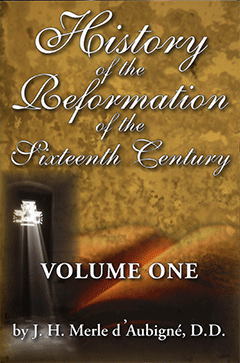 Jean-Henri Merle d’Aubigné was born at Eaux Vives, a neighbourhood of Geneva. A street in the area is named after him. The ancestors of his father Robert Merle d’Aubigné (1755–1799), were French Protestant refugees. The life Jean-Henri’s parents chose for him was in commerce; but in college at the Académie de Genève, he instead decided on Christian ministry. He was profoundly influenced by Robert Haldane, the Scottish missionary and preacher who visited Geneva and became a leading light in Le Réveil, a conservative Protestant evangelical movement.
Jean-Henri Merle d’Aubigné was born at Eaux Vives, a neighbourhood of Geneva. A street in the area is named after him. The ancestors of his father Robert Merle d’Aubigné (1755–1799), were French Protestant refugees. The life Jean-Henri’s parents chose for him was in commerce; but in college at the Académie de Genève, he instead decided on Christian ministry. He was profoundly influenced by Robert Haldane, the Scottish missionary and preacher who visited Geneva and became a leading light in Le Réveil, a conservative Protestant evangelical movement.
It was in small extra-curricular groups led by Haldane, that Merle d’Aubigné and his peers studied the Bible; according to church historian John Carrick, no classes were offered in the Christian scriptures at the school at that time, their having been replaced by the ancient Greek scholars.
When Merle d’Aubigné went abroad to further his education in 1817, Germany was about to celebrate the tercentenary of the Reformation; and thus early he conceived the ambition to write the history of that great epoch. Studying at Berlin University for eight months 1817–1818, Merle d’Aubigné received inspiration from teachers as diverse as J. A. W. Neander and W. M. L. de Wette.
In 1818, Merle d’Aubigné took the post of pastor of the French Protestant church at Hamburg, where he served for five years. In 1823, he was called to become pastor of the Franco-German Brussels Protestant Church and preacher to the court of King William I of the Netherlands of the House of Orange-Nassau.
During the Belgian revolution of 1830, Merle d’Aubigné thought it advisable to undertake pastoral work at home in Switzerland rather than accept an educational post in the family of the Dutch king. The Evangelical Society had been founded with the idea of promoting evangelical Christianity in Geneva and elsewhere, but a need arose for a theological seminary to train pastors. On his return to Switzerland, Merle d’Aubigné was invited to become professor of church history in such a seminary, and he also continued to labor in the cause of evangelical Protestantism. In him the Evangelical Alliance found a hearty promoter. He frequently visited England, was made a D.C.L. v Oxford University, and received civic honors from the city of Edinburgh. He died suddenly in 1872.
The first portion of Merle d’Aubigné’s Histoire de la Reformation – History of the Reformation of the Sixteenth Century – which was devoted to the earlier period of the movement in Germany, i.e., Martin Luther’s time, at once earned a foremost place among modern French ecclesiastical historians, and was translated into most European languages. The second portion, The History of the Reformation in Europe in the Time of Calvin, dealing with reform in the French reformer’s sphere, exhaustively treats the subject with the same scholarship as the earlier work, but the second volume did not meet with the same success. It is part of the subject Merle d’Aubigné was most competent to discuss, and was nearly completed at the time of his death. Such was the scope Merle d’Aubigné’s scholarship and his level of dedication, states church historian John Carrick, that Merle d’Aubigné ” visited the major libraries of Central and Western Europe in order to read original documents in Latin, French, German, Dutch, and English.”
Among minor treatises authored by Merle d’Aubigné, the most important are his vindication of the character and the aims of Oliver Cromwell, and his sketch of the trendings of the Church of Scotland.
![]()
top
History of the Council of Constance: Jacques L’enfant
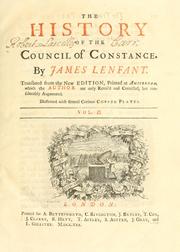 Jacques Lenfant (April 13, 1661, Bazoches-en-Dunois, La Beauce – August 7, 1728, Berlin), French Protestant divine, was born at Bazoches-en-Dunois in 1661, son of Paul Lenfant, Protestant pastor at Bazoche and afterwards at Châtillon-sur-Loing until the revocation of the edict of Nantes, when he moved to Marburg in the Landgraviate of Hesse-Kassel.
Jacques Lenfant (April 13, 1661, Bazoches-en-Dunois, La Beauce – August 7, 1728, Berlin), French Protestant divine, was born at Bazoches-en-Dunois in 1661, son of Paul Lenfant, Protestant pastor at Bazoche and afterwards at Châtillon-sur-Loing until the revocation of the edict of Nantes, when he moved to Marburg in the Landgraviate of Hesse-Kassel.
After studying at Saumur and Geneva, Lenfant completed his theological course at Heidelberg, where in 1684 he was ordained minister of the French Protestant church, and appointed chaplain to the dowager electress palatine. When the French invaded the Electorate of the Palatinate in 1688 Lenfant withdrew to Berlin, as in a recent book he had vigorously attacked the Jesuits. Here in 1689 he was again appointed one of the ministers of the French Protestant church; this office he continued to hold until his death, ultimately adding to it that of chaplain to the king, with the dignity of Consistorialrath. He visited Holland and England in 1707, preached before Queen Anne, and, it is said, was invited to become one of her chaplains. He was the author of many works, chiefly on church history. In search of materials he visited Helmstedt in 1712, and Leipzig in 1715 and 1725. He died at Berlin on 7 August 1728.
An exhaustive catalogue of his publications, thirty-two in all, will be found in J. G. de Chauffepié’s Dictionnaire. See also Eugène and Émile Haags’ La France Protestante. He is now best known by his Histoire du Concile de Constance (Amsterdam, 1714; 2nd ed., 1728; English trans., 1730). It is of course largely dependent upon the laborious work of Hermann von der Hardt (1660-1746), but has literary merits peculiar to itself, and has been praised on all sides for its fairness. It was followed by Histoire du Concile de Pise (1724), and (posthumously) by Histoire de la guerre des Hussites et du Concile de Basle (Amsterdam, 1731; German translation, Vienna, 1783-1784). Lenfant was one of the chief promoters of the Bibliothèque Germanique, begun in 1720; and he was associated with Isaac de Beausobre (1659-1738) in the preparation of the new French translation of the New Testament with original notes, published at Amsterdam in 1718. Source: Jacques L’enfant – Wikipedia
Download Links
![]()
top
History of the Life and Sufferings of the Reverend and Learned John Wycliffe
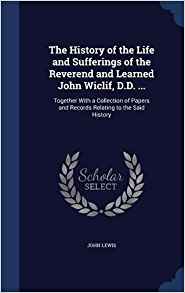 John Wycliffe (also spelled Wyclif, Wycliff, Wiclif, Wicliffe, Wickliffe; 1320s – 31 December 1384) was an English scholastic philosopher, theologian, Biblical translator, reformer, and seminary professor at Oxford. He was an influential dissident within the Roman Catholic priesthood during the 14th century.
John Wycliffe (also spelled Wyclif, Wycliff, Wiclif, Wicliffe, Wickliffe; 1320s – 31 December 1384) was an English scholastic philosopher, theologian, Biblical translator, reformer, and seminary professor at Oxford. He was an influential dissident within the Roman Catholic priesthood during the 14th century.
Wycliffe attacked the privileged status of the clergy, which was central to their powerful role in England. He then attacked the luxury and pomp of local parishes and their ceremonies.
Wycliffe was also an advocate for translation of the Bible into the vernacular. He completed a translation directly from the Vulgate into Middle English in the year 1382, now known as Wycliffe’s Bible. It is probable that he personally translated the Gospels of Matthew, Mark, Luke, and John; and it is possible he translated the entire New Testament, while his associates translated the Old Testament. Wycliffe’s Bible appears to have been completed by 1384, additional updated versions being done by Wycliffe’s assistant John Purvey and others in 1388 and 1395.
Wycliffe’s followers were known as Lollards and followed his lead in advocating predestination, iconoclasm, and the notion of caesaropapism, while attacking the veneration of saints, the sacraments, requiem masses, transubstantiation, monasticism, and the very existence of the Papacy.
Beginning in the 16th century, the Lollard movement was regarded as the precursor to the Protestant Reformation. Wycliffe was accordingly characterised as the evening star of scholasticism and the morning star of the English Reformation. Wycliffe’s writings in Latin greatly influenced the philosophy and teaching of Czech reformer Jan Hus, whose execution in 1415 sparked a revolt and led to the Hussite Wars. Source: Wikipedia
Download Link: History of the Life and Sufferings of the Reverend and Learned John Wycliffe
![]()
top
Life of Luther: Barnas Sears
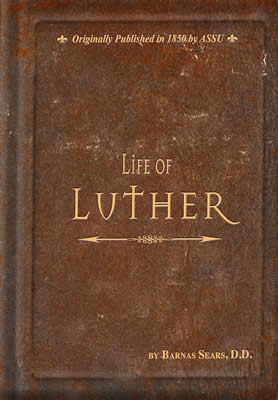 Barnas Sears (November 19, 1802 – July 6, 1880) graduated from Brown University in 1825. Sears was the general agent of the Peabody Education Fund who was sent to Staunton, Virginia, by George Peabody to offer leadership in Public Education. Sears was General Agent of the fund from 1867 until February 1880. He settled in Staunton because of the easy access to the railroad.
Barnas Sears (November 19, 1802 – July 6, 1880) graduated from Brown University in 1825. Sears was the general agent of the Peabody Education Fund who was sent to Staunton, Virginia, by George Peabody to offer leadership in Public Education. Sears was General Agent of the fund from 1867 until February 1880. He settled in Staunton because of the easy access to the railroad.
Sears travelled extensively throughout the south promoting Southern education, “free schools for the whole people”. Sears “inspired confidence, removed doubts and suspicions, and aroused sympathy” through his warm personality, tact, and intelligence.
“Under his direction the Fund improved the sentiment for education in the South, developed the idea of adequate taxation for public schools, and helped remove the hostility toward Black education.”
Sears served between 1855 and 1867 as the president of Brown whose Encyclopedia Brunoniana offers a more detailed biography.
His home at Staunton, known as the Sears House, was added to the National Register of Historic Places in 1972. Source: Wikipedia Barnas Sears
Download Link: Life of Luther
![]()

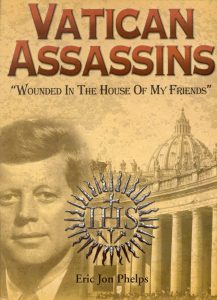
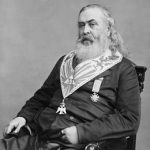
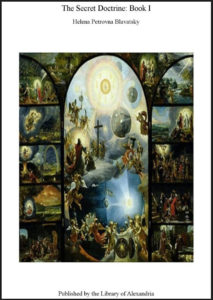
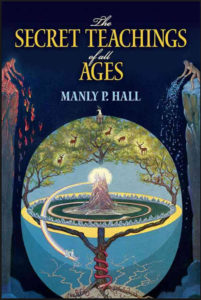
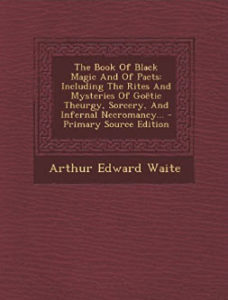
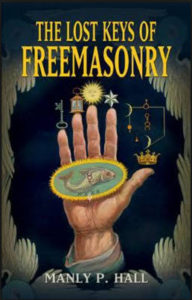
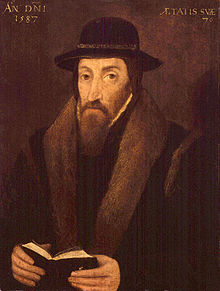
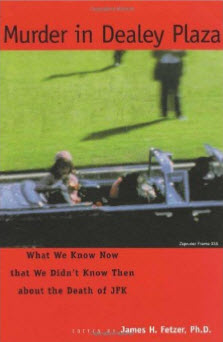
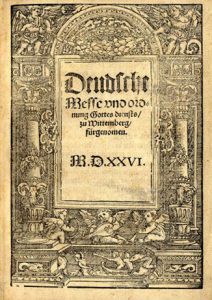
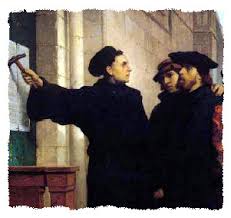
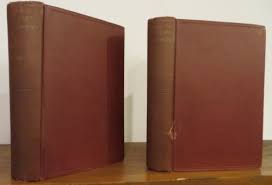
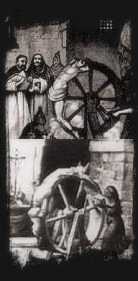
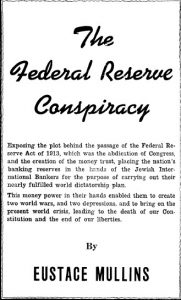
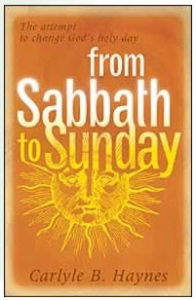
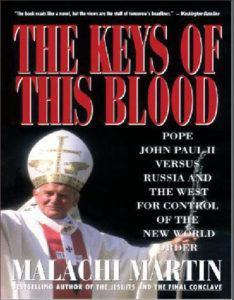
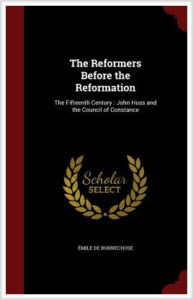

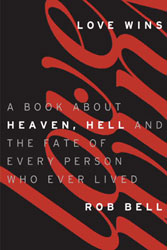 In Chapter Four of Love Wins, Bell criticizes some statements of faith that he has taken from evangelical church websites that reflect Jesus’ teachings on Hell: “The unsaved will be separated forever from God in hell.” After giving a number of examples with which he feels uncomfortable, Bells states,
In Chapter Four of Love Wins, Bell criticizes some statements of faith that he has taken from evangelical church websites that reflect Jesus’ teachings on Hell: “The unsaved will be separated forever from God in hell.” After giving a number of examples with which he feels uncomfortable, Bells states, 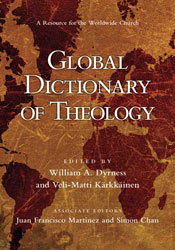 The emergent-friendly, Global Dictionary of Theology, makes a distinction between ‘Hopeful Universalism’ and ‘Convinced Universalism’:
The emergent-friendly, Global Dictionary of Theology, makes a distinction between ‘Hopeful Universalism’ and ‘Convinced Universalism’: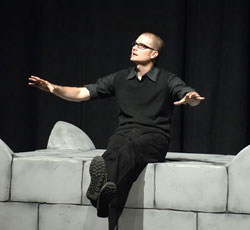 Indeed, in the very preface of Love Wins, Bell contradicts Jesus’ teaching that few would actually be saved. Bell writes:
Indeed, in the very preface of Love Wins, Bell contradicts Jesus’ teaching that few would actually be saved. Bell writes: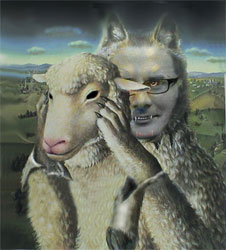 It is a sobering thought that Jesus went on to state in the verses immediately following His teaching on the narrow and broad roads, that false prophets would come in sheep’s clothing (Matthew 7:15-21). Such false prophets stand at the cross roads between the broad and narrow road, claiming to represent Christ, while pointing their followers toward the broad road that leads destruction, assuring them that it eventually leads to Heaven. Consider this for a minute. Isn’t this exactly what Rob Bell is doing?
It is a sobering thought that Jesus went on to state in the verses immediately following His teaching on the narrow and broad roads, that false prophets would come in sheep’s clothing (Matthew 7:15-21). Such false prophets stand at the cross roads between the broad and narrow road, claiming to represent Christ, while pointing their followers toward the broad road that leads destruction, assuring them that it eventually leads to Heaven. Consider this for a minute. Isn’t this exactly what Rob Bell is doing? Rob Bell not only redefines Hell by teaching that it will only be a temporary abode for those who want to leave later, but he redefines Hell by claiming that it is not so much about the after life, but it’s about what you make of the life here and now. In his book, Velvet Elvis, Bell had already stated this position:
Rob Bell not only redefines Hell by teaching that it will only be a temporary abode for those who want to leave later, but he redefines Hell by claiming that it is not so much about the after life, but it’s about what you make of the life here and now. In his book, Velvet Elvis, Bell had already stated this position: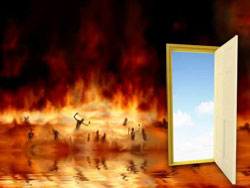 Rob Bell takes every possible liberty to deny reality and to either explain Hell away or get everyone into Heaven, regardless of his or her rejection of God and the Gospel. Bell not only empties Hell of God’s holy wrath, he creates an exit door from the inside out and claims that Hell is merely what we make it. He also claims that most of the imagery of future judgments in Hell were fulfilled on earth in AD 70 (p. 81).
Rob Bell takes every possible liberty to deny reality and to either explain Hell away or get everyone into Heaven, regardless of his or her rejection of God and the Gospel. Bell not only empties Hell of God’s holy wrath, he creates an exit door from the inside out and claims that Hell is merely what we make it. He also claims that most of the imagery of future judgments in Hell were fulfilled on earth in AD 70 (p. 81).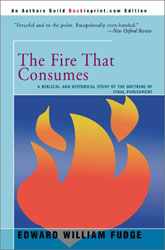 By claiming that the unrepentant wicked will have a chance to get to Heaven from Hell, Rob Bell has gone beyond that of Edward W. Fudge, who states in The Fire That Consumes,
By claiming that the unrepentant wicked will have a chance to get to Heaven from Hell, Rob Bell has gone beyond that of Edward W. Fudge, who states in The Fire That Consumes, 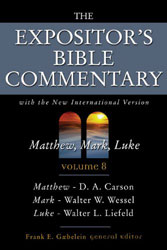 Biblical Scholar D.A. Carson, commenting on Matthew 25:46, says :
Biblical Scholar D.A. Carson, commenting on Matthew 25:46, says :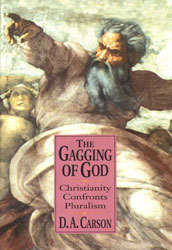 “What is hard to prove, but seems to me probable, is that one reason why the conscious punishment of hell is ongoing is because sin is ongoing.”
“What is hard to prove, but seems to me probable, is that one reason why the conscious punishment of hell is ongoing is because sin is ongoing.” There is hardly any wiggle room for a second chance in hell in these passages or anywhere in Scripture. Bell would have his readers believe of the book of Revelation that
There is hardly any wiggle room for a second chance in hell in these passages or anywhere in Scripture. Bell would have his readers believe of the book of Revelation that  May God give us the grace, in these times of apostasy, to hold fast to Jesus’ teachings and remain faithful to our loving and Holy Lord to the end. May God deliver His bride from the cotton candy Christianity that is endemic in Emergent Churches and among false prophets who lead the lost into believing they can put off repentance until after death.
May God give us the grace, in these times of apostasy, to hold fast to Jesus’ teachings and remain faithful to our loving and Holy Lord to the end. May God deliver His bride from the cotton candy Christianity that is endemic in Emergent Churches and among false prophets who lead the lost into believing they can put off repentance until after death.